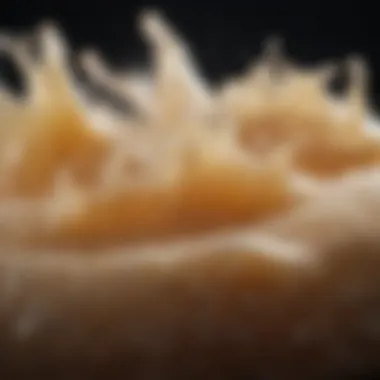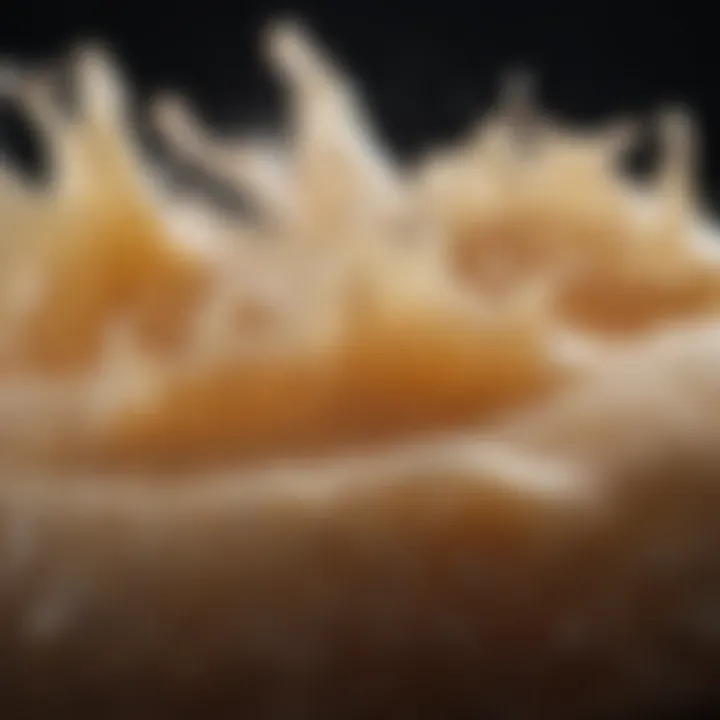The Science of Shampoo: Boosting Hair Strength & Thickness


Intro
The relationship between shampoo formulations and hair health is often overlooked. Many assume that any product will suffice for their hair care needs. However, the reality is more nuanced. Understanding the science behind shampoo is crucial for promoting stronger and thicker hair. The ingredients found in shampoos can significantly influence hair vitality and density, catering to diverse needs based on hair types.
Moreover, user practices play a vital role in how effective these shampoos can be. The goal of this article is to dissect these elements, providing clarity on how specific formulations can affect the strength and thickness of hair. By analyzing various ingredients and considering hair biology, we can equip readers with the right knowledge for healthier hair.
Key Trends
Overview of Current Fashion Trends
In the world of beauty, trends often dictate consumer choices. Recently, there has been a shift towards more natural ingredients in beauty products. This change is motivated by a growing awareness of the potential harm that synthetic components can cause. Shampoos with organic and plant-based ingredients are gaining popularity. People increasingly want formulations free from sulfates, parabens, and artificial fragrances, which can strip hair of its natural oils.
Additionally, there is a trend focusing on tailored hair care. This involves selecting shampoos that cater specifically to individual hair types and conditions, whether that be oily, dry, or chemically treated hair. The understanding that one size does not fit all in hair care is reshaping how products are marketed and consumed.
Popular Beauty Trends
Another prominent trend is the use of targeted treatments. Many consumers are now looking for shampoos that address specific issues such as hair thinning or scalp health. For instance, formulations containing biotin or caffeine are thought to invigorate hair follicles and promote growth.
In addition, brands are utilizing technology to create innovative products. Personalized hair care quizzes and algorithms that recommend specific products based on hair conditions are making it easier for consumers to make informed decisions.
"Choosing the right shampoo formulation is not just about aesthetics; it’s also about the health benefits that the right ingredients can provide."
The Role of Ingredients in Hair Health
Understanding how ingredients affect hair is essential. Common ingredients include surfactants, conditioners, and active agents. Surfactants cleanse the hair by removing dirt, oils, and buildup. Among these, sodium lauryl sulfate is one of the most common, yet it can be harsh on hair. Alternatives like sodium coco-sulfate are milder options worth considering.
Conditioners work to soften the hair and improve manageability. Ingredients such as aloe vera and argan oil not only hydrate but also provide added strength. Active ingredients like keratin help reconstruct damaged hair, while essential oils can enhance scalp health.
Summary
When choosing a shampoo, consumers must consider various factors including ingredients, hair type, and specific concerns. This article serves as a guide to demystifying the science behind shampoos. With greater knowledge of formulations, one can make choices that truly enhance hair strength and thickness.
Understanding Hair Structure and Growth
Understanding hair structure and growth is central to comprehending how shampoo formulations can influence hair strength and thickness. Hair is not just a superficial aspect of beauty; it reflects health and well-being. The intricate biology of hair plays a crucial role in how shampoos work. Different hair types react differently to various formulations. Therefore, knowing hair anatomy and the growth cycle can lead to better product choices and hair care practices.
The Anatomy of Hair
Hair is composed primarily of a protein called keratin, which gives it strength. Each hair strand has three primary layers:
- Cuticle: The outer layer consists of transparent scales. It protects the inner layers and contributes to the hair's shine and smoothness. A healthy cuticle should lie flat and be intact.
- Cortex: This middle layer makes up most of the hair's mass. The cortex contains the pigment that gives hair its color. It also plays a vital role in hair strength and elasticity. Treatments that damage the cortex can lead to weakness.
- Medulla: The innermost layer is often absent in fine hair types. It is thought to influence the flexibility of the hair strand.
Understanding the composition of hair helps consumers choose shampoos that enhance these layers. For instance, products designed to smooth or repair cuticles can contribute to overall hair strength.
Hair Growth Cycle
Hair goes through a growth cycle consisting of three distinct phases:
- Anagen Phase: This is the growth phase where hair develops actively from the follicles. It can last several years, depending on genetic factors and health.
- Catagen Phase: The transitional phase follows growth. During this time, hair stops growing and detaches from the follicle, lasting a few weeks.
- Telogen Phase: This is the resting phase before hair sheds. It lasts about three months before new hair pushes the old out.
Understanding these phases is vital because various factors can impact the cycle. For example, stress or poor nutrition can prolong shedding and impact hair thickness. A suitable shampoo can support healthy hair cycles by nourishing the scalp and maintaining cleanliness.
"The journey of hair, from growth to shedding, reveals much about its health and how to care for it effectively."
By grasping the fundamentals of hair anatomy and growth, one can appreciate the significance of targeted shampoo formulations designed to foster thicker and stronger hair. Pursuing knowledge in this area is not just recommended; it is essential for anyone serious about their hair care.
Challenges to Hair Health
Understanding the challenges that impact hair health is essential for those seeking to maintain or improve the strength and thickness of their locks. Various factors contribute to hair weakness, and navigating these can often feel overwhelming. Stress, poor nutrition, and environmental influences are just a few elements that can substantially affect hair quality. Recognizing these challenges not only helps in addressing the issues but also in selecting suitable shampoo formulations that target specific problems.
Common Causes of Hair Weakness
Hair weakness can stem from numerous sources, both internal and external.
- Genetics: Genetic predisposition plays a significant role in determining hair strength and thickness. If family members have experienced hair loss or thinning, it may impact you as well.
- Nutritional Deficiencies: A balanced diet is crucial for robust hair. Lack of essential nutrients, like proteins, vitamins, and minerals, can lead to brittle strands. For instance, vitamins such as B-complex, particularly biotin, are important for hair health.
- Hormonal Changes: Hormonal fluctuations during events like puberty, pregnancy, or menopause can lead to changes in hair density. Estrogen and testosterone levels often influence hair growth and retention.
- Medical Conditions: Certain medical conditions such as thyroid disorders and alopecia can affect hair strength and health. A healthcare professional should be consulted if significant changes are observed.
- Chemical Damage: Continuous use of hair dyes, relaxers, and other chemical treatments can weaken hair structure. It is vital to consider the impact of these treatments on your hair’s overall vitality.
These factors create a complicated web of influences affecting hair health. Addressing these challenges can allow individuals to make informed decisions about their hair care routines, including the choice of shampoo formulations.
Environmental Factors Affecting Hair
Environmental influences are an unavoidable aspect that can hinder hair health. Understanding these factors is important for creating an effective hair care strategy. Some significant environmental contributors include:
- UV Radiation: Prolonged exposure to sunlight can damage hair cuticles, leading to dryness and brittleness. UV rays can weaken the hair protein, keratin, making it vulnerable.
- Pollution: Airborne pollutants, such as dust and smoke, can settle on the scalp and hair. This can lead to buildup, irritate the scalp, and even contribute to issues like dandruff.
- Humidity and Climate: Different climates affect hair texture and manageability. High humidity can make hair frizzy, while dry conditions can lead to a lack of moisture.
- Water Quality: Hard water, containing high levels of minerals like calcium and magnesium, can build up on hair, making it feel rough and lifeless.
"Understanding environmental impact on hair health is the first step towards effective care."
Navigating these challenges effectively requires not only awareness but also adopting appropriate care routines. With targeted shampoo formulations, one can mitigate the impact of these factors, promoting stronger and thicker hair.
Role of Shampoo in Hair Care
Shampoo plays a critical role in maintaining hair health and beauty. It is not merely a cleansing agent; its formulation can significantly affect the condition of hair. The importance of shampoo derives from its ability to remove dirt, oil, and product buildup from the scalp and hair shafts. This cleansing process is fundamental for promoting a healthy environment for hair growth.
The right shampoo can contribute to the strength and thickness of hair by providing the necessary nutrients through its ingredients. A better understanding of how shampoo works helps in selecting the appropriate product for different hair types and conditions. Also, recognizing that not all shampoos are created equal is vital. Some are designed for specific concerns, while others offer generalized care. This differentiation will be explored in detail in the following subsections.
Purpose of Shampoo
The primary purpose of shampoo is to cleanse the hair and scalp. It removes excess sebum, environmental pollutants, and styling products. By keeping the scalp clean, shampoo encourages healthy hair growth. Additionally, shampoo can prepare the hair for further treatments, such as conditioning or styling. It can improve the effectiveness of these products by eliminating barriers created by dirt or oil. The use of shampoo also provides an opportunity to address specific hair concerns through targeted formulations.


Many shampoos contain surfactants, which are compounds that help to lift dirt and oil away from the hair and scalp. Surfactants vary in gentleness, affecting who can use them. Natural or milder surfactants are ideal for sensitive scalps or damaged hair, while stronger formulas might be appropriate for oily hair types.
Types of Shampoos Available
Understanding the different types of shampoos available can help consumers make informed choices. There are several categories of shampoos, tailored for distinct hair types and needs:
- Clarifying Shampoo: Designed for deep cleansing, this type removes heavy buildup from products and pollutants. However, it should be used sparingly to avoid stripping hair of natural oils.
- Moisturizing Shampoo: Formulated to add hydration and nourishment, this shampoo is ideal for dry or damaged hair, helping to improve texture and manageability.
- Volumizing Shampoo: Aimed at creating body and fullness, this shampoo is particularly beneficial for fine or limp hair.
- Color-Safe Shampoo: This type helps maintain the vibrancy of color-treated hair by avoiding harsh chemicals that can result in fading.
- Sulfate-Free Shampoo: Often gentler, sulfate-free shampoos are favored for sensitive skin and are less likely to strip natural oils.
Different products contain various ingredients aimed at addressing specific needs. Formulations can be complex and may include additional elements such as proteins, vitamins, and botanical extracts to maximize benefits. With many choices now available, identifying the right type can profoundly influence hair health and appearance.
"Educating oneself about shampoo formulations can lead to more informed choices, resulting in healthier hair."
Choosing the right shampoo involves considering individual hair types, scalp conditions, and goals for hair health. As we progress, it is essential to be aware of how the chosen formulations integrate with other hair care practices.
Key Ingredients for Stronger Hair
The selection of the right ingredients in shampoo formulations plays a crucial role in enhancing hair strength and thickness. Understanding these components allows consumers to make informed choices when selecting products. Skilfully chosen ingredients not only cleanse but also fortify hair, helping to maintain its integrity against various damaging factors. This section explores essential ingredients that contribute to healthier hair, examining their distinct benefits and considerations.
Proteins in Hair Care
Proteins are fundamental to the structure of hair. Keratin, the primary protein found in hair strands, is essential for strength and resilience. Shampoos enriched with hydrolyzed proteins can penetrate the hair shaft, thereby reinforcing it and preventing breakage. Ingredients like keratin, silk protein, and wheat protein are popular in formulations aimed at strengthening hair.
- Keratin: Often derived from animal sources, keratin infuses strength back into damaged hair. Its molecular structure does not just coat but also binds with natural keratin, enhancing overall strength.
- Silk Protein: This ingredient helps in moisture retention. The amino acids in silk protein form a protective barrier, shielding hair from environmental stress.
- Wheat Protein: Rich in amino acids, this protein hydrates hair and improves manageability. It is known for its ability to improve elasticity, which is vital in preventing hair from breaking under strain.
Key Considerations
Choosing shampoos with protein can restore damaged hair to a healthier state. However, excessive use of protein can lead to stiffness. Balance is essential. It is recommended to alternate protein-rich products with moisturizing ones to maintain hair flexibility and moisture balance.
Vitamins and Minerals
Vitamins and minerals significantly impact hair health. These nutrients play various roles, from promoting growth to preventing loss. Incorporating shampoos that contain essential vitamins can lead to improved hair vitality.
- Vitamin E: Known for its antioxidant properties, Vitamin E helps to reduce oxidative stress on the scalp, promoting a healthier environment for hair growth.
- Vitamin B Complex: This group of vitamins, including biotin, supports hair growth. Biotin, in particular, is frequently highlighted for its role in increasing thickness.
- Zinc: This mineral is essential as it plays a crucial role in tissue growth and repair. Zinc deficiency can contribute to hair thinning, making it an important mineral in hair care formulations.
Important Notes
When selecting shampoos, look for those that specify the sources of vitamins and minerals. Not all vitamins are equally bioavailable, so the source dramatically affects their efficiency.
Herbal Extracts and Oils
Herbal extracts and oils have gained popularity in shampoo formulations for their nurturing properties. Many of these ingredients have been used for centuries in traditional remedies for hair care, providing a natural approach to enhance hair strength and thickness.
- Aloe Vera: This plant extract is renowned for its hydrating properties. Aloe Vera not only moisturizes hair but also soothes the scalp, which can improve overall hair health.
- Rosemary Oil: Known for its stimulating properties, rosemary oil can improve circulation to the scalp, promoting hair growth and preventing hair loss.
- Argan Oil: Rich in essential fatty acids and vitamin E, argan oil nourishes the hair, adding shine and softness without weighing it down.
Considering Natural Ingredients
Consumers often seek shampoos with natural ingredients due to their minimal side effects. However, always check for possible allergens before trying new natural products. A patch test might be beneficial to assess potential reactions.
"Choosing the right shampoo involves understanding how ingredients interact with your hair and scalp, thus maximizing their benefits for healthier hair."
By focusing on proteins, vitamins, minerals, and herbal extracts, individuals can choose formulations that not only cleanse but also strengthen and thicken their hair. A scientific approach to ingredients can lead to better grooming practices and healthier results.
Formulations for Thickening Hair
Understanding formulations that promote thicker hair is critical for those seeking solutions to hair density and volume. The right shampoo can make a tangible difference in hair's overall health and appearance. Choosing a shampoo that focuses on thickening and volumizing can lead to immediate results, making hair feel more robust while enhancing long-term growth.
Sulphate-Free Shampoos
Sulphate-free shampoos have gained popularity for their gentler formulation compared to traditional shampoos that contain sodium lauryl sulphate and other harsh detergents. Sulphate-free options do not strip hair of its natural oils. This is essential when aiming for thicker, healthier hair.
Using sulphate-free shampoos retains moisture and reduces frizz, resulting in a smooth appearance. Moreover, skipping sulphates often helps in mitigating scalp irritation, allowing the hair shaft to remain unharmed. A healthier scalp can promote better hair growth, as it creates a nourishing environment for new strands.
Shampoos with Volumizing Agents
Volumizing shampoos incorporate specific ingredients, like polymers or proteins, that coat the hair strands and create the perception of added volume. These formulations usually lift hair from the roots. This can make it appear thicker without weighing it down.
Utilizing volumizing shampoos can result in customers enjoying more body in their hair. Ingredients such as hydrolyzed wheat or silk proteins strengthen the shafts, allowing them to hold their shape more effectively. This is particularly advantageous for fine or limp hair types. However, it's advisable to ensure that such shampoos do not contain overly heavy ingredients that may lead to build-up.
Conditioning Shampoos
Conditioning shampoos serve dual purposes: cleansing the hair while also adding moisture and softness. These formulations often contain conditioning agents that improve manageability and minimize damage. The presence of ingredients like glycerin or aloe vera aids in hydration, giving a thicker overall appearance.
With regular use, conditioning shampoos can cultivate healthier hair strands. This can lead to improved elasticity and a reduction in breakage. They are especially beneficial for those experiencing dryness or brittleness in their hair. Thus, incorporating a conditioning shampoo into the routine can be a worthwhile investment.
The goal of a good shampoo formulation is not only to wash hair but also to enhance its natural beauty and strength.
In summary, understanding various formulations can lead one to healthier choices that contribute to thicker hair. Evaluating the specific needs of one's hair type is crucial in selecting the most appropriate product.
Shampoo Application Techniques
Shampoo application is a critical aspect of hair care, yet it is often overlooked. Proper techniques can enhance the effectiveness of shampoo, leading to healthier and stronger hair. Understanding the nuances in application can help users achieve the desired results more effectively.
Proper Washing Techniques
The foundation of effective shampooing lies in the proper washing techniques. Start by wetting the hair thoroughly with lukewarm water. This temperature helps to open the hair cuticles, allowing the shampoo to penetrate more deeply. Next, apply an appropriate amount of shampoo, typically the size of a quarter for shoulder-length hair. Rub the product between your palms before applying it, ensuring even distribution.
While massaging the shampoo into the scalp, focus on using fingertips, not nails, to avoid irritating the scalp. Circular motions will stimulate blood circulation, which can promote hair growth. Ensure to cover the entire scalp, as neglecting areas can lead to product buildup, which may hinder hair health. When the scalp is well-lathered, gently squeeze the length of the hair to cleanse it without causing damage.
Importance of Rinsing


Rinsing is a step that cannot be underestimated. Proper rinsing is crucial to remove all shampoo residues. Leaving any product behind can lead to scalp irritation and a less than optimal appearance of hair. After working the shampoo into the hair and scalp, rinse thoroughly under lukewarm water. It helps to ensure that the cuticles remain open, enhancing the cleansing process.
Consider rinsing until the water runs clear. This indicates that the shampoo is fully washed away. Afterward, a brief cool rinse can close the hair cuticles, which may result in shinier and smoother hair. Skipping rinsing or rushing through this step can compromise the overall effectiveness of the shampoo.
Frequency of Shampoo Usage
The frequency with which one shampoos their hair is a personal choice, but it can significantly impact hair health. Over-washing can strip natural oils, which protects the hair and maintains moisture. Therefore, understanding individual hair type and lifestyle is vital.
For individuals with oily hair or larger amounts of product buildup, washing every day or every other day may be necessary. However, those with dry or curly hair may benefit from washing only once or twice a week. It is important to pay attention to how the hair responds to different washing frequencies. Adjusting regular shampooing habits according to hair texture and scalp condition can lead to better hair vitality.
Consistent shampoo application techniques along with correct frequency can transform the health and appearance of hair.
Impact of Hair Treatments on Shampoo Efficacy
Understanding the effects of hair treatments on shampoo efficacy is vital for anyone seeking to maintain or enhance hair health. Various treatments can significantly alter the hair structure and its response to shampoo products. When engaged in chemical treatments or heat styling, it is essential to recognize how these processes affect the hair's condition, thus influencing how shampoos work.
Chemical Treatments
Chemical treatments, such as coloring or perming, can lead to drastic changes in hair texture and strength. These treatments alter the hair's natural structure by breaking down the bonds within the hair shaft. After such treatments, hair may become more porous and prone to damage, which requires specific care.
For example, shampoos formulated for chemically treated hair often include gentle cleansers designed to avoid further stripping of natural oils. Key ingredients, like hydrolyzed proteins, are aimed at repairing the hair shaft, helping to restore strength while maintaining vibrancy. Using regular shampoos may not provide the necessary care and may strip the hair of needed moisture, which can worsen its condition.
In addition, users should be cautious about sulfates in shampoos which can be harsh on already chemically exposed hair. Opting for sulfate-free formulas can beneficially affect the hair, keeping it moisturized and manageable.
Heat Styling Tools
Heat styling tools, such as curling irons and flat irons, add another layer of complexity to maintaining healthy hair. The frequent exposure to high temperatures can cause the hair cuticle to become brittle and lead to split ends. Similar to chemical treatments, heat styling necessitates special consideration in shampoo selection.
Shampoos containing protective ingredients are advantageous. For instance, products that include silicones can coat the hair and create a barrier against heat. Additionally, shampoos with anti-oxidants may help neutralize damage from free radicals exacerbated by heat exposure. Users should also consider the temperature at which they style their hair and incorporate products that mitigate heat damage.
"Understanding the interaction between hair treatments and shampoo is essential for achieving and maintaining optimal hair health. Different treatments require tailored products to protect and enhance hair vitality."
Personalizing Your Shampoo Choice
Personalizing your shampoo choice plays a crucial role in maintaining and enhancing hair health. It is not merely a cosmetic decision; it involves understanding the unique characteristics of your hair and scalp to select the most appropriate formulation. With the vast array of products on the market, the right shampoo can significantly impact the quality and strength of your hair.
Identifying Hair Type
Determining your hair type is the first step in choosing the right shampoo. Hair can be categorized in various ways, such as straight, wavy, curly, or coily. Each type has specific care requirements. For example, straight hair tends to get oily faster and may need a clarifying shampoo. On the other hand, curly and coily hair often requires more moisture and may benefit from hydrating formulas infused with oils or shea butter.
Additionally, hair texture—fine, medium, or coarse—also influences shampoo selection. Fine hair requires lightweight products to prevent flattening, while coarse hair may need richer, creamier formulations for better hydration and manageability. Ultimately, understanding your unique hair type allows for a more targeted approach, improving your hair's overall health and resilience.
Understanding Scalp Conditions
The condition of your scalp is just as important as the hair itself. Various scalp types—oily, dry, or sensitive—demand different care routines. For instance, an oily scalp may require a shampoo formulated with tea tree oil or salicylic acid to help control excess sebum. Alternatively, a dry or sensitive scalp might benefit from a gentle, sulfate-free shampoo that focuses on hydration and soothing ingredients.
It's also essential to recognize any scalp conditions like dandruff or psoriasis, as these may necessitate specialized treatment shampoos. Not only does this focus on the scalp improve hair health, but it also promotes an optimal environment for hair growth.
"A tailored approach to shampoo selection can greatly enhance the strength and appearance of your hair."
When you understand both your hair type and scalp condition, you can make informed choices that lead to better results. By personalizing your shampoo routine, you elevate your hair care regimen to meet your specific needs, ultimately achieving stronger and thicker hair.
Integrating Auxiliary Products
In the quest for optimal hair health, integrating auxiliary products alongside your shampoo can significantly enhance results. Auxiliary products refer to any additional treatments you may use in conjunction with shampoo, such as conditioners, treatments, hair masks, and oils. These products provide targeted benefits that shampoo alone may not achieve, fostering stronger and thicker hair.
One key consideration is the interplay between your shampoo and these auxiliary products. Each serves a unique purpose, yet they also complement each other. For instance, after cleansing the hair, conditioners can replenish moisture lost during shampooing, which is critical for maintaining healthy hair fibers.
Conditioners and Treatments
Conditioners are often overlooked, yet they play an essential role in hair care. Unlike shampoos that remove dirt and oils, conditioners aim to hydrate and detangle hair. They can include various ingredients designed to protect the hair's cuticle, the outer layer that shields inner structures.
Benefits of Conditioners:
- Moisture Retention: Conditioners help to lock in moisture, preventing dryness.
- Damage Repair: Many conditioners contain proteins and ceramides that can repair damage from heat styling or environmental factors.
- Manageability: Use of conditioners leads to smoother hair, making it easier to style.
Products like the Moroccan Oil Conditioner provide rich hydration and fortification due to its argan oil content. Treatments such as leave-in conditioners extend the benefits of traditional rinsing formulas, providing continuous care throughout the day.
Hair Masks and Oils
Hair masks and oils represent another layer of auxiliary care, designed to offer intensive nourishment. Masks are typically thicker than conditioners and are left on the hair for an extended period. They deliver concentrated ingredients that can deeply penetrate the hair shaft, offering a restorative effect.
Hair Mask Applications:
- Hydration: Masks often contain oils and humectants that provide deep moisture, transforming dry hair into soft and manageable strands.
- Strengthening: Ingredients like keratin work to rebuild the hair structure, making it less prone to breakage.
- Scalp Care: Some masks target the scalp directly, addressing issues like flakiness or oiliness.
On the other hand, oils serve a specific purpose. They can help to seal moisture and add shine without weighing down the hair. A product like coconut oil can act as a natural protector against sun damage and heat while providing essential fatty acids for overall hair health.
In summary, integrating auxiliary products allows for a more comprehensive approach to hair care. Conditioners foster moisture retention and manageability, while masks and oils provide deep nourishment. Therefore, choosing the right combination of products tailored to individual hair needs is crucial for achieving not only thicker and stronger hair but also healthier hair overall.
Consumer Awareness and Product Transparency
In an era of heightened consumer advocacy, the focus on product transparency within the beauty industry, particularly regarding shampoo formulations, cannot be overstated. As consumers become more educated, they demand clarity about what goes into their hair care products. This shift is not merely a trend; it represents a fundamental change in how brands communicate the benefits and potential drawbacks of their shampoos.
Understanding ingredients and their functions is vital. Knowledge about surfactants, thickeners, and moisturizers can significantly influence consumer choices. With terms like "sulfate-free" and "paraben-free" becoming commonplace, it is essential for consumers to understand these ingredients' actual impacts on hair health. Transparency allows consumers to make informed decisions that can enhance their hair strength and thickness.
Moreover, product labeling is a critical component of consumer awareness. Labels should clearly list ingredients, yet many brands engage in vague marketing that obscures meanings. This can lead to misunderstandings regarding product effectiveness. Brands that prioritize clarity and detail in their communication build trust, which is fundamental for customer loyalty.


Benefits of Consumer Awareness and Product Transparency
- Informed Choices: Enhanced understanding of ingredients leads to better product selection, aligning choices with personal hair care needs.
- Trust Building: Brands that provide transparent information foster trust, compelling consumers to remain loyal.
- Hair Health Advocacy: A more informed consumer base can inspire better hair health practices, influencing others positively in their community.
While evaluating shampoo, consumers should consider various aspects of product transparency for optimal hair care. It is their right to know how a product was designed and what scientific research backs its claims.
Reading Labels Effectively
Understanding how to read labels permits consumers to discern product quality. Ingredients are typically listed in descending order. Thus, the highest concentrations appear first. Familiarizing oneself with common chemical names can also help identify potentially harmful substances.
Key components to focus on include:
- Surfactants: These ingredients are responsible for cleansing. Types include sodium lauryl sulfate and ammonium lauryl sulfate.
- Preservatives: Often indicated by names like parabens, these maintain product shelf-life but can cause irritation in sensitive users.
- Conditioning Agents: Ingredients such as silicones can offer temporary shine and manageability; however, they can also lead to product buildup over time.
A few tips for effective label reading:
- Look out for natural and organic certifications.
- Be cautious of incomprehensible scientific names. If an ingredient is hard to pronounce, do more research on it.
- Check for any certifications or claims, such as cruelty-free or vegan labels, that align with personal values.
Evaluating Product Claims
Consumer skepticism is reasonable, given the relentless marketing ploys designed to influence purchasing decisions. Therefore, evaluating product claims requires a critical approach informed by science and experience. Many brands tout their shampoos as "miracle solutions" for hair issues, but the lack of regulation often allows for exaggerated statements.
A discerning consumer must:
- Cross-reference claims with scientific sources. Research studies may provide evidence of an ingredient's effectiveness.
- Look up third-party reviews or feedback on platforms like Reddit and Facebook to gauge real-world results.
- Understand that personal hair care needs vary. A product that works for one person might not yield the same results for another due to unique hair types and scalp conditions.
"A well-informed consumer is an empowered one. Those who actively seek information about their chosen products contribute to a culture of accountability and transparency in the beauty industry."
In summary, consumer awareness and product transparency are pivotal in fostering a better understanding of hair care products. By engaging actively with labels and critically assessing claims, individuals can make informed decisions that enhance their hair health.
Sustainable Choices in Hair Care
Sustainable choices in hair care have gained prominence as users become more aware of the environmental implications of their beauty routines. With growing evidence of climate change and resource depletion, many consumers seek products that minimize ecological impact. This section explores how sustainable choices can benefit both the environment and individuals seeking healthier hair.
One key aspect of sustainable hair care is the reduction of harmful ingredients commonly found in shampoos. Many traditional formulations contain sulfates, parabens, and synthetic fragrances that can cause environmental harm and may not be beneficial for hair health. By choosing eco-friendly shampoos, consumers can support brands that prioritize natural ingredients, reduce their carbon footprint, and promote a cleaner planet.
Moreover, sustainable practices often lead to better hair health over time. Since eco-friendly formulations typically include organic and plant-based ingredients, they tend to nourish hair more effectively. This is accomplished through gentle cleansing without stripping natural oils, which can lead to healthier, stronger hair.
Eco-Friendly Formulations
Eco-friendly formulations are designed with both hair health and environmental sustainability in mind. These products often feature a range of natural ingredients such as aloe vera, coconut oil, and shea butter, which help to cleanse and condition without the use of harsh chemicals. Choosing shampoos that emphasize organic components can provide a gentler alternative, reducing the risk of irritation and adverse reactions.
When scrutinizing eco-friendly products, it is essential to look for certifications that validate their claims. Labels such as USDA Organic or EcoCert indicate a product has met established environmental standards. This gives consumers the assurance that they are making responsible choices that align with their values.
Furthermore, many eco-friendly shampoos also avoid animal testing, appealing to ethically conscious consumers. Supporting these brands contributes to a more humane beauty industry.
Zero-Waste Options
Zero-waste options have emerged as a progressive solution in the pursuit of sustainable hair care. These products aim to eliminate packaging waste and encourage consumers to reduce their environmental footprint. Refills, solid shampoos, and bar soaps are examples of zero-waste alternatives that are gaining traction.
Solid shampoo bars are noteworthy for their compact design. They often come with minimal packaging, which drastically reduces plastic waste. Additionally, these bars are highly concentrated, which means a little goes a long way, promoting cost-effectiveness.
Some brands now offer refill stations where consumers can bring their own containers to fill up, further emphasizing a waste-free approach. This shift not only diminishes plastic pollution but also fosters a culture of conscious consumption.
Future Trends in Hair Care Technology
The hair care industry is evolving at a rapid pace. Staying informed on the latest trends in hair care technology is crucial for consumers who want to maintain healthy and vibrant hair. This section delves into the advancements that are shaping the future of hair care, focusing on innovative ingredients and essential delivery systems. Understanding these trends helps users make informed decisions when selecting products.
Innovations in Ingredients
Recent developments in ingredient technology are transforming shampoo formulations. One significant trend is the incorporation of biotechnology-derived ingredients. These elements, such as peptides and amino acids, are designed to strengthen hair from within. By mimicking the natural proteins found in hair, they provide targeted benefits. For example, keratin-derived products help in repairing damage, while silk proteins improve texture and shine.
Another noteworthy innovation includes the use of natural preservatives. Traditional preservatives like parabens are being replaced with more natural alternatives, such as rosemary extract and tocopherol. These offer better safety profiles while maintaining product efficacy. Additionally, there is a surge in utilizing plant-based oils like argan and coconut, known for their hydrating properties. This shift not only benefits hair health but also aligns with growing consumer preferences for clean beauty.
"Innovative ingredients are key to enhancing the effectiveness of hair care products and cater to the evolving needs of consumers who value both results and safety."
Advancements in Product Delivery Systems
The effectiveness of a hair product is largely determined by how well its ingredients can penetrate the hair shaft. This underscores the importance of product delivery systems. Recent advancements have focused on enhancing the absorption of beneficial ingredients.
One emerging trend is the use of nanotechnology. By reducing particle size, active ingredients can more easily penetrate the outer layers of hair. This technology allows shampoos to deliver nutrients deep into the hair, significantly improving performance.
Additionally, researchers are exploring microencapsulation techniques. This involves enclosing active ingredients in tiny capsules to protect them from degradation until they are applied. When the shampoo is massaged into the scalp and hair, the capsules break open, releasing the active ingredients at optimal times. This ensures that the hair receives full benefit from the product.
Ending and Recommendations
The topic of shampoo formulations is crucial for anyone seeking to improve the health of their hair. Understanding how different ingredients impact hair strength and thickness allows individuals to make informed choices. This article has explored key elements that contribute to hair vitality.
One must consider the science behind the ingredients used in shampoos. Proteins, vitamins, and herbal extracts play significant roles, promoting stronger and thicker hair. Moreover, awareness of environmental factors and individual hair types is essential in selecting the appropriate product.
Summarizing Key Points
The relationship between shampoo formulations and hair health is multifaceted. Here are the main takeaways from this article:
- Hair Structure: Knowing the anatomy of hair and its growth cycle is vital for understanding how to care for it.
- Common Weaknesses: Identifying causes of hair weakness can help in prevention strategies.
- Role of Ingredients: Key ingredients such as proteins and vitamins are fundamental in strengthening hair. Each has its unique benefits that support overall hair health.
- Personalization: Choosing the right shampoo depends on individual hair types and scalp conditions.
- Sustainability: More consumers are seeking eco-friendly options that do not compromise efficacy.
"The right shampoo can lead to noticeable changes in hair thickness and strength. It's not just about cleansing, but nourishing the hair as well."
Guidelines for Selecting Shampoo
Selecting the right shampoo requires careful consideration of various factors:
- Identify Your Hair Type: Determine if your hair is oily, dry, straight, or curly. This will influence the type of shampoo you need.
- Check Ingredients: Look for shampoos with beneficial ingredients like keratin for strength and natural oils for moisture. Avoid sulfates if you have sensitive skin or color-treated hair.
- Consider Scalp Conditions: If you have dandruff or irritation, look for specialized shampoos that target those issues.
- Read Reviews: Customer feedback can provide insight into the effectiveness of a product.
- Trial and Error: Sometimes it takes a few different products to find the one that works best for you.
- Frequency of Use: Consider how often you wash your hair. Some shampoos are designed for daily use, while others may be more intensive treatments.
By keeping these factors in mind, consumers can effectively navigate the many choices available in the market and select shampoos that will enhance their hair health.



